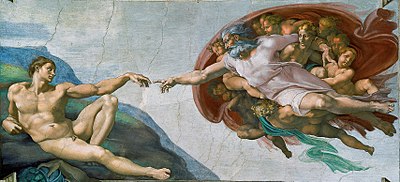Masterpiece

Amasterpiece,magnum opus,orchef-d'œuvre(Frenchfor 'master of work';pl.chefs-d'œuvre;French:[ʃɛ.d‿œvʁ]) in modern use is a creation that has been given much critical praise, especially one that is considered the greatest work of a person's career or a work of outstandingcreativity,skill, profundity, orworkmanship.
Historically, a "masterpiece" was a work of a very high standard produced to obtain membership of a guild or academy in various areas of the visual arts and crafts.

Etymology[edit]
The formmasterstikis recorded in English orScotsin a set ofAberdeenguild regulations dated to 1579, whereasmasterpieceis first found in 1605, already outside a guild context, in aBen Jonsonplay.[4]Masterprizewas another early variant in English.[5]

In English, the term rapidly became used in a variety of contexts for an exceptionally good piece of creative work, and was "in early use, often applied to man as the 'masterpiece' of God or Nature".[9]
History[edit]

Originally, the termmasterpiecereferred to a piece of work produced by anapprenticeorjourneymanaspiring to become amaster craftsmanin the old Europeanguildsystem. His fitness to qualify for guild membership was judged partly by the masterpiece, and if he was successful, the piece was retained by the guild. Great care was therefore taken to produce a fine piece in whatever the craft was, whether confectionery, painting,goldsmithing,knifemaking,leatherworking, or many other trades.
In London, in the 17th century, theWorshipful Company of Goldsmiths,for instance, required an apprentice to produce a masterpiece under their supervision at a "workhouse" inGoldsmiths' Hall.The workhouse had been set up as part of a tightening of standards after the company became concerned that the level of skill of goldsmithing was being diluted. The wardens of the company had complained in 1607 that the "true practise of the Art & Mystery of Goldsmithry is not only grown into great decays but also dispersed into many parts, so as now very few workmen are able to finish & perfect a piece of plate singularly with all the garnishings & parts thereof without the help of many & several hands...". The same goldsmithing organization still requires the production of a masterpiece but it is no longer produced under supervision.[10][11]
InNuremberg,Germany, between 1531 and 1572, apprentices who wished to become master goldsmith were required to producecolumbine cups,dies for a steel seal, and gold rings set with precious stones before they could be admitted to the goldsmiths' guild. If they failed to be admitted, then they could continue to work for other goldsmiths but not as a master themselves. In some guilds, apprentices were not allowed to marry until they had obtained full membership.[12]
In its original meaning, the term was generally restricted to tangible objects, but in some cases, where guilds covered the creators of intangible products, the same system was used. The best-known example today isRichard Wagner's operaDie Meistersinger von Nürnberg(1868), where much of the plot is concerned with the hero's composition and performance of a "masterpiece" song, to allow him to become ameistersingerin the (non-commercial) Nuremberg guild. This follows the surviving rulebook of the guild.
The practice of producing a masterpiece has continued in some modern academies of art, where the general term for such works is nowreception piece.TheRoyal Academyin London uses the term "diploma work"and it has acquired a fine collection of diploma works received as a condition of membership.
Modern use[edit]
In modern use, a masterpiece is a creation in any area ofthe artsthat has been given much critical praise, especially one that is considered the greatest work of a person's career or to a work of outstanding creativity, skill, profundity, or workmanship. For example, the novelDavid CopperfieldbyCharles Dickensis generally considered a literary masterpiece.[13][14][15]The term is often used loosely, and some critics, such as Edward Douglas ofThe Tracking Board,feel it is overused in describing recent films.[16]
See also[edit]
References[edit]
- ^"The Theft That Made Mona Lisa a Masterpiece".NPR.July 30, 2011.RetrievedFebruary 15,2019.
- ^"Why Mona Lisa Became An Icon".21 September 2001.
- ^Lichfield, John (April 2, 2005)."The Moving of the Mona Lisa".The Independent.Archivedfrom the original on 2022-05-12.
the best known, the most visited, the most written about, the most sung about, the most parodied work of art in the world
- ^OED:"Masterpiece". See also:Encarta.Archived2009-11-01.
- ^OED:"Masterprize"
- ^"Things Fall Apart by Chinua Achebe: 9780385474542 | PenguinRandomHouse.com: Books".PenguinRandomhouse.com.Retrieved2023-09-11.
- ^Obioma, Chigozie (2022-10-05)."Top 10 books about Nigeria".The Guardian.ISSN0261-3077.Retrieved2023-09-11.
- ^Hardison, Erika (2022-04-25)."15 Of The Best Nigerian Books By Nigerian Authors".BOOK RIOT.Retrieved2023-09-11.
- ^OED,and examples
- ^A History of the Goldsmiths' Company.The Goldsmiths' Company. Retrieved 30 December 2014.
- ^Goldsmiths' Company Apprenticeship Programme.Archived2014-12-30 atarchive.todayThe Goldsmiths' Centre. Retrieved 30 December 2014.
- ^Cup, Silver, room 69, case 25.Victoria & Albert Museum. Retrieved 30 December 2014.
- ^Forster, John (1976)."VII".Life of Charles Dickens.London: Everyman's Library. p.6.ISBN0460007823.
- ^"John Forster, The Life of Charles Dickens".Classic Literature.Retrieved26 June2012.
- ^Monod, Sylvère (1968).Dickens the Novelist.University of Oklahoma Press.ISBN978-0806107684.
- ^"Can We Please Stop Overusing the Word" Masterpiece "? (Opinion)".February 17, 2018.
